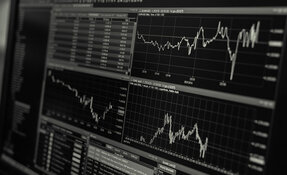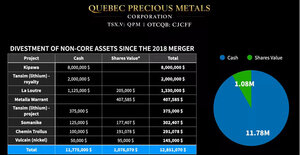Stephen Taylor: This fund is designed to focus on profitable niches wherever they may exist. Currently, we favor small-cap companies and emerging markets. We have a very broad investor mandate: our goal is to deliver absolute performance.
Our investor base is a pretty sophisticated group that I met in the Chicago trading community when I worked as a floor trader in the late '80s and early '90s. Many of our investors have been sounding boards that we share ideas with and they understand our style. They're patient and tolerant of extra volatility. The fund is an exclusive, closed fund, but may reopen to new investors in early 2011.
We try to find those niches that are undiscovered at any given time. We can trade anything that moves, so to speak. Recently, we've been finding opportunities in the emerging markets and natural resource spaces.
I work as the portfolio manager of the fund and spend my time between Chicago, Los Angeles and on the road visiting companies. Bob Kirkland, who I brought in to be president of the firm, handles the back office and the administrative side of the company. We've known each other for over 20 years and he has held top jobs at several trading firms. Research Analyst Christopher Kliner joined us from Deutsche Bank in the spring and is also based in our Chicago office. Steve Digilio heads up our research effort in the New York office, focusing mainly on financial firms. Jeff Maher, our chief operating officer, worked with me on the fund's launch; he now works directly with me on a variety of projects for the firm. Recently, we have been spending a lot of time in California on one of our large positions, Meruelo Maddux Properties (OTCBB:MMPIQ), which is the largest private landowner in downtown Los Angeles and is also in Chapter 11.
We bought this stock because we believed it had significant equity value even though the company filed for Chapter 11. We began aggressively buying it and became the second-largest shareholder in the company. Management's initial restructuring plan treated the minority shareholders terribly. We asked the court for an equity-holder committee, which was granted. I'm told that occurs in only 2% of bankruptcy cases, but we were successful in persuading the court. I'm chairing that committee now. We have been able to negotiate substantially more for the minority shareholders, but it's taken a lot of our time.
TGR: Let's talk about your research methodology.
ST: We use a variety of sources and combine a top-down macro view with bottom-up company analysis. We use a grassroots network. A lot of our best ideas come from people and companies that have worked well for us in the past. We also run a number of stock screens on a regular basis; for example, we look at big movers, new highs and lows, Chapter 11 filings and spinoffs. We also pick up ideas from trade publications, trade shows and the management teams of our existing portfolio companies. All of these things can bring a stock in the front door.
TGR: I know you have a wide network from your days at the Chicago Board Options Exchange, but you launched the fund in the fall of 2008—no more than six weeks after Lehman Brothers collapsed. Was it difficult to find people willing to put money into the market at that point?
ST: It was quite an experience. I announced that I would be launching the fund in an April-2008 email and indicated to my potential investors that we would be looking at a fourth-quarter launch. The following six months produced some of the most incredible headlines—Lehman went under, and there was AIG and Bear Stearns, and GM and Chrysler were in trouble. These were the types of headlines that hadn't been seen since the Great Depression.
I was concerned because we had a $10 million minimum launch target, which I believed was the minimum starting point to be considered credible and to position the fund to attract institutional money down the road. However, following my email, I received an indication of interest from many of my investors. We launched with 23 investors. I'm happy to say that every investor who made a commitment in April followed through on it in November. That really meant a lot to me and it says a great deal about our investors.
One thing that is a little unusual about our fund is that we require a three-year lockup. Lawyers and accountants were telling me I was crazy when I launched the fund, saying: "You have to promise people weekly or monthly liquidity!" I disagreed. That's part of what went wrong on Wall Street. People would promise their investors weekly or daily liquidity and then invest in things that couldn't be sold for three years. I believe that the better thing is to under-promise and over-deliver. Having a three-year lockup may mean that we don't attract as much capital in the beginning, that's fine. It's just the right way to do business. The fund will grow fast enough, if we do our job right.
TGR: What's the net asset value (NAV) of your fund right now?
ST: We are currently at about $45 million. Following the initial round of about $10 million, we had a gain of just over 120% in the first year of the fund. During that period, we received additional follow-on investment from existing investors of about $8 million. In January, we brought in five new investors with about $7 million. Most of my incentive fees have been reinvested in the fund. We haven't aggressively marketed the fund; we really haven't marketed at all. We prefer to grow in a measured, thoughtful way at a pace that allows us to put capital to work prudently and by building on our existing investor base. It's not all about trying to grab as much money under management as possible—it's about doing well with the money that you have and generating a good return for your investors.
TGR: You mentioned that your investors are tolerant of a little volatility. You certainly have had that in the last year: In May 2010, the fund was down almost 15%. There was another loss in June, a slight spike up in July, and then down again in September. It's been quite a ride. Does the three-year lockup allow you to ride out that kind of volatility?
ST: Yes. We're not the fund for everyone. We have found these niches to be profitable over the years. One of the downsides is increased volatility. It's both sides of the same coin: Volatility scares away a lot of investors, but it may allow for some of the inefficiency in pricing that helps us to outperform.
TGR: Last year, the fund was up almost 96%. This year, it's up about 11%. What's accounting for the drop?
ST: Really, an 11% return isn't bad. In all honesty, we had three large private-equity positions in China that we hoped would have liquidity events already. That took a little wind out of our sails. Another big reason is that I made bets throughout the year against large U.S. and European financial institutions—negative bets on the financial sector—because I was concerned with banking systems in Europe. I got a bit too pessimistic and underestimated the size and vigor of the government bailout. That cost us several percentage points.
TGR: In a January 2009 press release, you said, "I don't like our fund to be categorized." Despite tremendous pressure in the fund business to commit to a narrow niche, you believe that is counterproductive. You believe that it's important for a manager to have a broad range of strategies.
ST: Absolutely.
TGR: That bears out in the outline of your fund. It says in the prospectus that you can pretty much invest in anything.
ST: The trend in the hedge fund business over the last 10 years to increasingly narrow a fund's focus to a very tight category has been driven by tremendous pressure from fund of funds, institutional investors and marketers.
I co-managed the Chinamerica Fund, a China-focused fund, for more than four years; but to limit my choices to only Chinese investments today would be a problem. Yet, there are funds out there that are in very tight niches. It's difficult to generate absolute returns and performance if a fund is prevented from going where the opportunities are and is restricted to an area where there aren't opportunities. That's really going to impact performance. That's not what we're in business to do. We're in business to find opportunities, not wait for them to come to some narrowly defined niche.
TGR: Currently, about half of the assets of the Taylor Fund are in Chinese-related assets. I'm assuming that's due, in part, to your experience with this other fund.
ST: Yes, it is.
TGR: What sort of assets are these?
ST: They consist of some private-equity positions, but the bulk of them are in U.S.-listed Chinese companies. Some of them are companies that I worked with and took public at the Chinamerica Fund, others are companies that were brought to my attention by the network of contacts I established during my time with Chinamerica. When doing business and investing in China, it's extremely important to have the right partners. I think one of the biggest mistakes that international investors can make is going into China and not respecting that need.
What's going on in China right now is tremendous. A lot of wealth is being created. We think valuations are still very low for quality companies; but there's a lot of suspect stuff out there, as well. One has to be careful.
There are a lot of quality companies selling at very cheap prices; for example, we like Liandi Clean Technology Inc. (OTC:LNDT), which provides software and control components that help clean up oil refineries and chemical plants. We also like Longwei Petroleum Investment Holding Ltd. (NYSE.A:LPH) and Keyuan Petrochemicals Inc. (NASDAQ:KEYP), which is in the petrochemical and asphalt markets. Another is China Redstone Group Inc. (OTCBB:CGPI), which is the only public operator of cemeteries and funeral homes in China. We like China Golf, a private company that is the third-largest operator and developer of golf courses in China, Oumei Real Estate, which is also private and China-Biotics Inc. (NASDAQ:CHBT), the largest manufacturer of probiotics in China.
The common thread between all these Chinese investments is that they have easy-to-understand businesses focused on the domestic Chinese market. We try to avoid companies in fields where there are intellectual property issues in China. We try to focus on companies that are not export-oriented. We think that's important because we don't believe the export market for China will be as robust as it has been in the past.
TGR: Will Chinese investments continue to dominate the fund going forward?
ST: I suspect that you'll see the percentage of our fund dedicated to Chinese investments dropping over the next few quarters.
TGR: Is that due to the economic slowdown there?
ST: Some imbalances are building in China that are not appropriately priced by the market. Corriente Advisors recently put out a 27-page report that is one of the most thoughtful pieces on the Chinese economy and market that I've seen in a while. I'm a China bull, but it raised some issues that had me rethinking some of my positions. The report said that the Chinese money supply is a lot bigger than many people think. Relative to the size of their economy, it's a lot bigger than the U.S. money supply. The report questions whether the Chinese currency, the renminbi, will go up in value. And then there are the banking issues the rest of the world is wrestling with—it's the same thing in China.
The one-child policy is also doing a number on their demographics. No one is talking about what a nation of only-children will be like. I think that's a long-term question that is going be interesting.
TGR: It's something the world certainly hasn't seen before on that scale.
ST: Absolutely.
TGR: Do you have any Chinese mining companies?
ST: We think there are better mining jurisdictions around the world. That's led us to companies involved in Central and South America, Canada and the U.S., but nothing in China.
TGR: So, you own positions in quite a range of commodities: Nickel, vanadium, gold and silver. How do you choose which junior mining companies you take positions in?
ST: The first thing is always management. What many of our positions have in common is that they have management teams that we've known for a long time, that we've watched succeed in the past and that have previously generated wealth for shareholders. Investors should ask: Have the people making the promises, the managers of this company, actually done this before? That really counts for a lot with us and it's very important in the mining space.
I would point to Anfield Nickel Corporation (TSX-V:ANF) and Lumina Copper Corp. (TSX:LCC). Both of those companies, for example, have a connection to executives Ross Beaty and David Strang. David has worked with Ross for a number of years and frequently serves as a top executive or president for some of the entities in which Ross invests. The fund has participated in a number of companies in the copper space that Ross and his group have built up and then sold to other buyers. He seems very focused on creating shareholder value. He treats all the shareholders the same. He has a sense of business and ethics that seems to be very close to our own. He puts his own money on the line.
Ken Cunningham, the chief executive of Miranda Gold Corp. (TSX.V:MAD), has been a friend of mine for probably 15 years. I was an investor in the first round, after Ken and his friends and family. It also was coincidentally the first stock that I bought in this fund. I had run into Ken at the New Orleans Conference just after the launch of the fund. I said, "Ken, do you have any funds that are blowing out of your stock?" A lot of hedge funds were faced with redemptions at the time and they were being forced to sell. About a week later, Ken called and said there was a Swiss fund that had been hit with redemptions and was closing; it needed to sell a half-million shares of Miranda.
We like Miranda. It's got a terrific operating model. I love the project-generator model. The company's got a great land position and great joint venture (JV) partners. We also participated in the most recent financing last spring—conducted above market! Only Ken could place stock above the market. Rick Rule, the Lundin family and our fund were buyers. I really like what it's got going down in Colombia. We're also participating in Red Eagle Mining Corp., which Ian Slater is behind. Ian is on the board over at Miranda. He is setting Red Eagle up to pursue projects in Colombia, some of which are JVs with Miranda.
TGR: What's your outlook for gold and silver? Are you vested in bullion at all?
ST: Yes, I am personally but the fund is not. I would urge most investors to consider having at least a little physical gold. As long as central banks continue to print money at this rate, gold and silver prices are going to go higher. Gold and silver can't be printed. There's actually an increasing chance that we may see gold and silver play a role in the monetary systems of some countries going forward; but we'll see.
TGR: How are you leveraging yourself to silver?
ST: I like silver because it's the poor man's gold. It tends to have rallies at a much greater percentage. We were able to participate heavily in a recent offering for Silvermex Resources Ltd. (TSX.V:SMR) and to get a pretty significant position established quickly and easily. We also like the fact that it has some very experienced management—the ex-chairman of Hecla Mining Co. (NYSE:HL), for example. Silver Standard Resources Inc. (TSX:SSO; NASDAQ:SSRI) is involved as a "big brother" or "rich uncle," so to speak. The price of silver over the last several months has certainly made it a good investment for us.
We invested in Silvermex through a private placement in public equity (PIPE) transaction several months ago. We participate in a lot of PIPEs; we like them because a PIPE typically contains a warrant package. Due to our history with the options trading business, our fund and our investors are very familiar with warrants. They're sort of like options. We really like those instruments.
TGR: Did you get full warrants or half?
ST: On Silvermex, I believe it was half. We have warrants in many of our Chinese investments. Many funds get these warrants, assign them zero basis and decide they want to sell them—but they're not publicly traded. We can make a market in those and trade them privately; that's a little niche we've found.
TGR: Vanadium is a metal that's really hot right now due to its potential for use in batteries in place of lithium. You have a position in the vanadium play Largo Resources Ltd. (TSX.V:LGO). How did you get involved there?
ST: Largo is a company I had traded several years ago. When we were launching the fund, Largo needed to raise capital to exercise an option on a vanadium project in Brazil. Mark Brennan, who runs Largo, was a friend and I knew the company had this capital need coming up and felt it would be doing an offering. We thought the market was not giving them credit for the potential value of those deposits. We made our initial investment in December 2008 and we did a follow-up round at higher valuations. We are big believers in vanadium. Mark and his team have really been scrappy underdogs at several points in this story. In the end, it's going to work out very well for Largo and its shareholders.
TGR: Does the fact that there are almost 300 million shares outstanding reduce the upside potential?
ST: Yes and no. A simplified capital structure would attract more institutional interest, but on the other hand, a lot of people might stay away. That may have led to some inefficient pricing and could present an opportunity. Large share counts are becoming less of an issue because it's increasingly common to have these nine-digit share counts in Australia, Canada and Singapore. I think there's less of a stigma associated with that.
TGR: Is the amount of liquidity in that stock to your liking?
ST: It trades 1.5 million shares a day. That's fine. Having a three-year lockup lets us ease in and out. Sometimes it can take a while to build a position or to exit a position.
TGR: Do you have some parting thoughts for us on what's going on in the market and where you see it heading in the next 6–12 months?
ST: It really continues to be a stock-pickers market, just like the period of 1966 to 1982 when the broad averages essentially went nowhere to down. I think we've been in a similar period since 2001. The indexes may remain flat for several more years.
Beneath the surface, there are tremendous opportunities to find companies that have terrific stories and are making things happen. As a portfolio manager, when I look at the situation in a macro sense, it's easy to get depressed. But when I look at the portfolio from a bottom-up perspective, company by company, individual story by individual story, I see a lot of reasons for optimism. I see companies doing great things and applying new technology. Looking ahead, I think that's what may surprise people. Technology will play a huge role in the resurgence of the U.S. and Canadian markets. There are too many people wringing their hands, saying the sky is falling and the U.S. is falling apart. I respectfully disagree.
TGR: Thanks, Stephen.
Steve Taylor is chairman and CEO of Taylor Asset Management, a Chicago-based investment management firm focusing on small-cap domestic equities and emerging markets. He also serves as a portfolio manager for the Taylor International Fund, Ltd., a small-cap equity fund. In addition to emerging markets, Steve's area of expertise includes private equity, restructuring and turnaround situations and both small- and mid-cap companies. He has considerable experience in the natural resources and finance industries in Canada and China.
Want to read more exclusive Gold Report interviews like this? Sign up for our free e-newsletter, and you'll learn when new articles have been published. To see a list of recent interviews with industry analysts and commentators, visit our Expert Insights page.
DISCLOSURE:
1.) Brian Sylvester of The Gold Report conducted this interview. He personally and/or his family own shares of the following companies mentioned in this interview: None.
2.) The following companies mentioned in the interview are sponsors of The Gold Report: Miranda Gold, Silvermex and Largo Resources.
3.) Stephen Taylor and/or Taylor International Fund, Ltd. own shares of the following companies mentioned in this interview: Largo, Silvermex, Liandi, Longwei Petroleum, Keyuan Petrochemicals, China Redstone, China-Biotics, Anfield, Lumina, Miranda, Meruelo Maddux, China Golf, Red Eagle Mining and Oumei Real Estate.








































